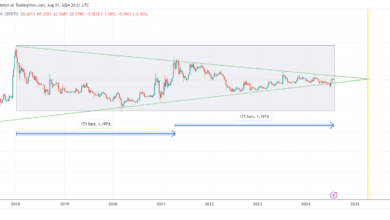Bitcoin Safe Haven: Insights into Market Trends and Tariffs

In the tumultuous landscape of financial markets, the question of whether Bitcoin is a safe haven asset has gained significant traction. As traditional investment avenues falter amidst the stock market decline, Bitcoin’s response to macroeconomic uncertainties is increasingly noteworthy. Recent cryptocurrency market trends reveal that while gold continues to reign as a solid safe haven, Bitcoin’s price has shown resilience, demonstrating an impressive gain of eight percent in the midst of chaos. With forecasts hinting at shifts in US interest rates outlook, savvy investors are exploring alternatives like Bitcoin to hedge against inflation and market volatility. This dialogue between gold vs Bitcoin has opened new avenues for secure investing, as many wonder if Bitcoin’s digital nature could redefine the very essence of safety in turbulent times.
In the current climate of economic unpredictability, the emergence of Bitcoin as a potential refuge for investors is becoming a compelling narrative. With the stock market under strain and traditional assets facing challenges, the appeal of cryptocurrencies as alternative stores of value is growing. As discussions on investment strategies evolve, experts are weighing Bitcoin against traditional safe havens like gold, while also contemplating the implications of fluctuating interest rates and ongoing economic policies. The ongoing volatility in global markets raises questions about the viability of both crypto assets and precious metals in providing security during financial upheavals. Increasingly, investors are turning their attention to how Bitcoin might serve as a protective measure, akin to well-established safe havens.
Bitcoin as a Safe Haven Asset in Times of Economic Uncertainty
As the global economy faces turbulent waters due to rising tariffs and fluctuating interest rates, investors are increasingly looking for refuge in assets deemed as safe havens. Traditionally, gold has been the go-to asset during financial storms, but Bitcoin is steadily establishing itself in this realm as well. With the S&P 500 experiencing a significant decline—down eight percent this month—Bitcoin’s recent performance highlights its potential as a viable alternative. Unlike stocks, which are heavily influenced by economic policies, Bitcoin offers a degree of independence, particularly during times of political and financial uncertainty.
The performance of Bitcoin during the current economic landscape raises the question of its status compared to gold. Analysts have noted that Bitcoin recently achieved an impressive eight percent monthly gain, outpacing other traditional investments. The surging demand for Bitcoin appears to be a response to the capital flight from US assets and the ongoing decline in the stock market. If current trends continue, Bitcoin could solidify its reputation as a safe haven asset, attracting those seeking stability in an unpredictable cryptocurrency market.
Comparing Gold vs Bitcoin: Which is the True Safe Haven?
Gold has long been regarded as the quintessential safe haven asset, consistently sought out during times of economic distress. However, as Bitcoin begins to mirror gold’s resilience, an intriguing comparison is emerging. With gold prices soaring by 30% since the beginning of the year, investors are questioning whether Bitcoin can achieve similar feats and ultimately earn the title of ‘digital gold.’ Experts in the cryptocurrency market predict that ongoing trends in macroeconomic factors, such as a potential decline in US interest rates, may propel Bitcoin’s value, positioning it as a form of wealth preservation just like gold.
As both assets react to shifts in the global economy, it’s important to consider how they will fare in a market marked by ongoing turmoil. Recent declines in the stock market and global monetary supply dynamics could play a significant role in determining whether Bitcoin can truly rival gold. The speculative nature of cryptocurrencies, juxtaposed with the long-established stability of gold, suggests that while Bitcoin may have potential as a safe haven, it still has ground to cover before it can fully compete with gold’s historical legacy.
Impact of Stock Market Decline on Cryptocurrency Investments
The stock market’s current downward trajectory invites scrutiny over how it affects the landscape of cryptocurrency investments. As traditional equities tumble, seeking alternative avenues has become paramount for many investors. The recent volatility has highlighted Bitcoin’s potential for strong performance even amidst economic strain. As the S&P 500 experiences dramatic fluctuations, the allure of cryptocurrencies is growing, offering a different risk profile and opportunities for substantial returns. Investors are now more inclined to diversify their portfolios by including cryptocurrencies, marking a significant shift in investment strategies.
Moreover, the historical correlation between Bitcoin prices and stock market performance is being tested. Earlier bullish runs for Bitcoin often mirrored stock market surges, but recent developments may indicate a potential decoupling. The existential crisis of the stock market may prompt investors to reassess their asset allocations, driving more capital towards Bitcoin and other cryptocurrencies as they search for resilience against further economic downturns. This transition could solidify Bitcoin’s status as a non-correlated asset within a diversified investment portfolio.
The Role of US Interest Rates in Shaping Cryptocurrency Trends
US interest rates are a critical factor affecting both traditional financial markets and cryptocurrencies. With the Federal Reserve’s reluctance to lower rates despite rising inflation pressures, many market analysts are now forecasting an easing of monetary policy this year. Such changes in the interest rate outlook can significantly impact investor sentiment across asset classes, including Bitcoin. As borrowing costs decrease, more liquidity could flow into riskier assets, potentially creating a favorable environment for Bitcoin to thrive.
On the flip side, if interest rates remain high or increase further, traditional assets may become more appealing to risk-averse investors. Higher interest rates tend to strengthen the US dollar; however, this dynamic can also lead to a liquidity crunch in the cryptocurrency market. Bitcoin’s growth prospects often hinge on the overall health of the global money supply, which is directly impacted by Federal Reserve policies. Thus, policymakers’ decisions regarding interest rates will undoubtedly influence Bitcoin’s valuation and its place in the broader economies.
Bitcoin Price Prediction Amidst Macroeconomic Uncertainty
Amidst the backdrop of fluctuating tariffs and concerns over a recession, Bitcoin’s price trajectory is a hot topic among investors and analysts alike. Experts continue to refine their predictions based on current market conditions and historical performance. Fundstrat’s Tom Lee recently commented that Bitcoin is on the verge of a significant rally, likely to catch up with gold as a leading safe haven. With Bitcoin trading at $94,000 and gaining traction against a weakening stock market, predictions suggest it may soon break past previous highs, potentially driven by a more favorable economic landscape.
Many factors will play a role in determining Bitcoin’s price, including geopolitical events, monetary policies, and changes within the cryptocurrency market itself. Analysts observing the global money supply and its correlation with Bitcoin performance are optimistic that continued growth is imminent. As recession fears potentially elicit capital reallocation to non-traditional assets, anticipating Bitcoin’s response becomes increasingly pertinent for stakeholders eager to capitalize on emerging opportunities in the evolving market.
Understanding Cryptocurrency Market Trends Post-Tariff Policies
Following the imposition of extensive tariffs by the US government, the response from the cryptocurrency market has been notably dynamic. Bitcoin’s subsequent rebound suggests a growing sentiment among investors to explore alternative assets as traditional securities falter. While cryptocurrencies initially felt the impact of tariff-related uncertainties, Bitcoin’s recent resilience and growth indicate a shift toward its perception as a viable investment avenue, particularly during periods of economic distress.
As the cryptocurrency market adjusts to the fallout from tariff policies, it is clear that investors are starting to view assets like Bitcoin as potential hedges against future economic instability. The ongoing evolution of technological advancements and regulatory clarity could foster further adoption of Bitcoin and other cryptocurrencies, driving market trends toward broader acceptance. By remaining attuned to these macroeconomic influences, stakeholders can better navigate the complexities of the cryptocurrency landscape.
How Tariffs Influence Gold and Bitcoin Dynamics
Tariffs serve as a significant market disruptor, affecting assets in varying degrees and prompting fluctuations in investor confidence. Central to this discussion is the relationship between gold and Bitcoin, both of which are now seen as alternatives during times of heightened volatility. When tariffs are enacted, traditional markets often face uncertainty, leading investors to flock to gold and Bitcoin as safeguards for their capital. As these assets strengthen, their dynamics in relation to one another will become increasingly important to observers of economic trends.
Notably, gold’s stellar 30% growth this year represents a remarkable performance that places it under scrutiny as Bitcoin emerges from its own downturn. If Bitcoin can continue to outperform significantly against declining stock indices, it solidifies its potential role alongside gold in a diversifying portfolio. Factors such as global liquidity, investor sentiment, and ongoing macroeconomic trends will shape how both gold and Bitcoin perform in light of fluctuating tariff impacts on the economy.
Capital Flight and Its Effects on Bitcoin Investment Strategies
In times of economic turbulence, capital flight becomes a critical factor influencing investment strategies. As investors seek out more stable and secure assets, Bitcoin and gold are witnessing enhanced demand, positioning them as attractive options during periods of uncertainty. The ongoing exodus from US equities due to tariff impositions underscores an emerging trend where more individuals and institutions are redirecting their capital towards cryptocurrencies. As this shift occurs, understanding the motivations behind capital flight is essential for predicting future growth in Bitcoin.
The response from the cryptocurrency sector to such movements is pivotal. Increased investments in Bitcoin may serve as a testament to its status as a non-correlated asset, prompting a reassessment of its role alongside traditional safe havens. As more investors recognize the implications of economic policies on their portfolios, Bitcoin stands to benefit significantly. This trend not only furthers its legitimacy within the financial ecosystem but also sets the stage for greater adoption and integration amidst ongoing economic uncertainties.
Future Outlook for Bitcoin in an Evolving Economic Landscape
The future of Bitcoin in an increasingly complex economic landscape is a topic of considerable debate among analysts and investors. With macroeconomic factors such as tariffs and interest rates shaping market dynamics, Bitcoin’s trajectory will likely be influenced by how well it can adapt to these changes. As emerging technologies and economic conditions evolve, Bitcoin’s role in the financial system will be scrutinized, particularly regarding its potential for growth and stability amidst ongoing fluctuations in traditional markets.
In assessing future price predictions for Bitcoin, it is crucial to incorporate insights from several indicators, including investor sentiment and the broader economic forecast. As confidence in traditional assets wanes, Bitcoin’s potential as a digital store of value becomes more appealing. The ongoing interplay between Bitcoin and macroeconomic factors will continue to shape its narrative as a safe haven asset as investors look for alternatives in times of financial uncertainty.
Frequently Asked Questions
Is Bitcoin becoming a safe haven like gold in the current market conditions?
Yes, Bitcoin is increasingly being viewed as a safe haven asset, particularly amid declining stock markets and macroeconomic uncertainty. In recent times, Bitcoin has shown resilience with an 8% monthly gain, suggesting it could follow in gold’s footsteps as a reliable asset during market downturns.
How does Bitcoin’s performance compare to gold during stock market declines?
During recent stock market declines, Bitcoin has outperformed traditional markets by 16 percentage points. While gold is well recognized as a safe haven, Bitcoin is emerging as a strong competitor, providing investors with an alternative during uncertain times.
What are the implications of US interest rates on Bitcoin as a safe haven investment?
As the likelihood of US interest rate cuts increases, Bitcoin may benefit from a weaker dollar and rising global liquidity. This environment typically supports Bitcoin’s price growth, as seen in the rising trend of the cryptocurrency market, paralleling the increase in the global money supply.
Can Bitcoin maintain its status as a safe haven amidst cryptocurrency market trends?
While Bitcoin is becoming increasingly recognized as a safe haven asset, its sustainability depends on its ability to remain uncorrelated with traditional markets during volatility. Investors should watch market reactions closely, especially in light of ongoing economic uncertainties and predictions of cryptocurrency market trends.
What role does the expansion of global money supply play in Bitcoin’s emergence as a safe haven?
The expansion of the global money supply M2 is crucial for Bitcoin’s growth as a safe haven asset. Increased liquidity tends to drive up Bitcoin prices, especially as inflation risks rise. This correlation highlights the potential of Bitcoin as an alternative asset amidst economic uncertainty.
How will Bitcoin react to potential sell-offs in the stock market?
The true test for Bitcoin as a safe haven will be its reaction to stock market sell-offs. If Bitcoin can demonstrate resilience and remain uncoupled from stock market trends in such scenarios, it may solidify its position as a preferred safe haven asset for investors.
What factors influence Bitcoin price prediction in terms of safe haven status?
Bitcoin price predictions as a safe haven asset are influenced by several factors, including macroeconomic trends, stock market performance, US interest rates outlook, and dollar weakness. Monitoring these elements can provide insights into Bitcoin’s future performance and its continued acceptance as a safe haven.
Can Bitcoin be a reliable alternative to gold for safe investments?
Bitcoin has shown potential as a reliable alternative to gold for safe investments as more capital seeks neutral assets. While gold currently holds a stronger safe haven reputation, Bitcoin’s recent performance and market trends indicate it is gaining traction and could become a favored option among investors.
| Key Point | Explanation |
|---|---|
| Macroeconomic Uncertainty | Capital markets are affected by tariffs, interest rates, and geopolitical issues. |
| S&P 500 Decline | The S&P 500 has dropped by 8% recently due to tariffs imposed by President Trump. |
| Gold’s Performance | Gold has increased by 30% this year, maintaining its status as a safe haven asset. |
| Bitcoin’s Recovery | Bitcoin has gained 8% this month, outperforming the S&P 500 by 16 percentage points. |
| Global Money Supply M2 | The expansion of global money supply is supporting Bitcoin’s price growth. |
| Interest Rate Speculation | There are expectations for interest rates to decrease, which may favor Bitcoin and other assets. |
| Market Risks | Potential sell-off risks remain despite Bitcoin’s recent performance; it still needs to prove its value as an uncorrelated asset. |
Summary
Bitcoin safe haven status has been a pivotal consideration in the current financial landscape, especially amidst rampant macroeconomic instability. As traditional markets falter under tariffs and fluctuating interest rates, Bitcoin is emerging as a potential safe haven asset. While it has shown a robust performance, indicating resilience and the capacity to function independently of traditional market trends, the ultimate question remains: can Bitcoin sustain this status in the longer term? The interplay of global liquidity, monetary policy shifts, and market reactions will significantly influence Bitcoin’s future as a reliable safe haven asset.



